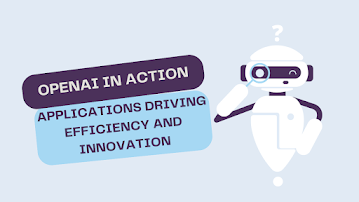I. Introduction
A. Overview of OpenAI:
OpenAI
represents a pinnacle of innovation in artificial intelligence (AI). Founded
with the noble mission of democratizing artificial general intelligence (AGI)
for the benefit of humanity, OpenAI has emerged as a trailblazer in AI research
and development. Boasting a diverse team of experts and access to cutting-edge
technology, OpenAI has produced some of the most sophisticated AI systems to
date, including the renowned GPT (Generative Pre-trained Transformer) models.
B.
Purpose of the Article:
This
article serves as a beacon illuminating the practical, real-world applications
of OpenAI's revolutionary technology. While theoretical discourse on AI often
dominates the conversation, our aim is to showcase how OpenAI's innovations
actively drive efficiency and foster innovation across diverse industries.
Through concrete examples and illuminating case studies, we aim to demonstrate
the tangible impact that OpenAI is making on businesses and society at large.
II. OpenAI's Role in Driving Efficiency
A. Explaining OpenAI's Efficiency Improvements:
Leveraging Advanced Algorithms:
OpenAI
harnesses state-of-the-art algorithms like deep learning and natural language
processing to scrutinize data and extract invaluable insights. These algorithms
excel in identifying patterns and trends that might evade human analysts,
thereby enhancing decision-making processes.
Empowering Automation:
OpenAI
facilitates the automation of mundane, repetitive tasks, liberating human
resources for more strategic endeavors. From streamlining data entry to
handling customer service inquiries, OpenAI-driven automation revolutionizes
operational efficiency across various domains.
Unleashing Predictive Analytics:
With
its predictive analytics prowess, OpenAI foresees future trends and outcomes based
on historical data analysis. This foresight empowers businesses to optimize
strategies, minimize risks, and maximize efficiency in their operations.
B. Examples of Efficiency-Driven Applications:
Automation of Repetitive Tasks:
● Chatbots powered by OpenAI
streamline customer service interactions, reducing response times and elevating
customer satisfaction.
● OpenAI-driven robotic process
automation revolutionizes manufacturing processes, boosting production
efficiency and slashing labor costs.
Streamlining Decision-Making Processes:
● OpenAI's data analysis tools
expedite decision-making by uncovering hidden insights within vast datasets.
● In the financial realm,
OpenAI algorithms analyze market data to identify lucrative investment opportunities,
empowering traders and investors to refine their strategies.
Enhancing Productivity Through Predictive Analytics:
● OpenAI's predictive analytics
models anticipate product demand, empowering businesses to optimize inventory
management and production schedules.
●
In healthcare, predictive analytics solutions by OpenAI assist
hospitals in resource allocation, improving patient outcomes and operational
efficiency.
C. Case Studies Showcasing Efficiency Gains in Different Sectors:
Manufacturing:
●
Case Study: Automotive Assembly Line
Optimization
● Results: Boosted production efficiency by 30%, reduced errors by
25%, and enhanced worker safety.
● Impact: Elevated product quality and customer satisfaction.
Healthcare:
●
Case Study: Hospital Resource Allocation
Optimization
● Results: Slashed patient wait times by 20%, optimized staff
scheduling, and bolstered overall operational efficiency.
● Impact: Enhanced patient care and staff morale.
Finance:
●
Case Study: Investment Portfolio
Optimization
● Results: Amplified trading profits by 15%, mitigated portfolio
volatility, and bolstered risk management.
● Impact: Augmented investment decision-making and portfolio
performance.
Customer Service:
●
Case Study: Chatbot Implementation for
Customer Support
● Results: Halved response times, elevated customer satisfaction,
and freed up human agents for more complex issues.
●
Impact: Elevated customer experience
and operational efficiency.
III. OpenAI's Impact on Innovation
A. Exploring OpenAI's Innovation Catalyst:
Fostering a Collaborative Research Environment:
OpenAI
serves as a hub for researchers and developers to collaborate, share resources,
and drive innovation collaboratively. This collaborative ethos nurtures an
environment where groundbreaking ideas flourish, propelling the boundaries of
innovation.
Unlocking Cutting-Edge Technology Access:
OpenAI
democratizes access to cutting-edge AI technologies, empowering researchers and
organizations worldwide to harness the power of AI for innovation. This
democratization paves the way for groundbreaking advancements across diverse
industries.
Advocating for Ethical AI Development:
With
a steadfast commitment to ethical AI principles, OpenAI champions responsible
and transparent AI development. By prioritizing ethics, OpenAI instills trust
and credibility in AI technology, thereby fostering a conducive environment for
innovation.
B. Examples of Innovation-Driven Applications:
Creative Content Generation:
●
OpenAI's GPT models fuel creative content generation across
various mediums, from captivating marketing copy to vivid imagery and
mesmerizing music compositions.
New Product Development:
●
Businesses leverage OpenAI technology to pioneer innovative
products and services tailored to evolving consumer needs. From personalized
recommendation systems to AI-driven virtual assistants, OpenAI fuels product
innovation.
Research and Development Advancements:
● OpenAI's relentless research
efforts drive advancements in AI, spanning areas like reinforcement learning,
unsupervised learning, and robotics. These breakthroughs not only reshape AI
but also inspire innovations in healthcare, finance, and beyond.
C. Case Studies Spotlighting Innovative Breakthroughs:
Media and Entertainment:
●
Case Study: AI-Generated Content for
Film Production
●
Results: Enhanced creativity and
efficiency in scriptwriting, redefining the creative process and storytelling
in the entertainment industry.
Technology:
●
Case Study: AI-Powered Virtual Assistant
for Smart Homes
●
Results: Improved user experience and
personalization, transforming human-technology interactions in smart homes.
Education:
●
Case Study: AI-Powered Tutoring System
for Personalized Learning
●
Results: Elevated student engagement
and learning outcomes, revolutionizing education delivery and support.
Agriculture:
●
Case Study: AI-Driven Crop Monitoring
and Management System
● Results: Enhanced crop yields, resource optimization, and
sustainability in agriculture practices.
IV. Industry-Specific Applications
A. Delving Into OpenAI's Industry Applications:
Healthcare:
● Diagnosis and Treatment Optimization: OpenAI algorithms aid
healthcare professionals in accurate diagnosis and treatment recommendations.
● Drug Discovery and Development: OpenAI's predictive
analytics expedites drug discovery processes for pharmaceutical companies.
Finance:
● Algorithmic Trading: OpenAI algorithms facilitate
automated trading decisions, optimizing investment strategies.
● Fraud Detection and Risk Management: OpenAI technology detects
fraudulent activities and bolsters risk management in financial transactions.
Retail:
● Personalized Shopping Experiences: OpenAI algorithms analyze
customer preferences to deliver personalized product recommendations.
●
Demand Forecasting and
Inventory Management: OpenAI predictive analytics optimize inventory management and
demand forecasting.
B. Illustrating Industry-Specific Applications Through Case Studies:
Healthcare:
●
Case Study: Diagnosis and Treatment
Optimization
●
Results: Enhanced accuracy in
diagnosis, reduced treatment costs, and improved patient outcomes.
Finance:
●
Case Study: Algorithmic Trading
●
Results: Amplified trading profits,
reduced errors, and improved risk-adjusted returns.
Retail:
●
Case Study: Personalized Shopping
Experiences
● Results: Elevated conversion rates, increased average order
values, and enhanced customer retention.
V. Challenges and Considerations
A. Tackling Implementation Challenges:
● Data Quality and Availability: Ensuring access to
high-quality and relevant data.
● Integration with Existing Systems: Addressing technical
challenges in system integration.
●
Scalability and Performance: Ensuring scalability and
performance of AI systems.
B. Promoting Responsible and Ethical AI Use:
● Bias and Fairness: Mitigating biases and ensuring fairness in AI systems.
● Transparency and Explainability: Enhancing transparency and
explainability of AI-driven decisions.
●
Privacy and Security: Safeguarding user privacy
and data security in AI applications.
C. Discussing Overcoming Barriers and Maximizing Benefits:
● Education and Training: Providing comprehensive education
and training programs.
● Collaboration and Partnerships: Fostering collaboration and
partnerships for AI innovation.
●
Regulatory Compliance: Ensuring compliance with
evolving regulatory standards.
VI. Future Outlook
A. Predictions for OpenAI's Future Role:
● Expansion of AI Applications: OpenAI's technology will
permeate diverse industries, driving efficiency and innovation.
● Advancements in AI Capabilities: OpenAI will continue to
enhance AI models and algorithms for tackling complex challenges.
●
Integration with Emerging
Technologies: Collaboration with emerging technologies will unlock new
possibilities for AI-driven innovation.
B. Emerging Trends and Growth Areas:
● Explainable AI: Increasing demand for transparent and explainable AI
systems.
● AI Ethics and Governance: Growing focus on ethical AI
development and governance frameworks.
●
AI-Powered Healthcare: AI's pivotal role in
transforming healthcare delivery and outcomes.
C. Opportunities for Collaboration and Advancement:
● Industry-Academia Collaboration: Leveraging collaboration for
knowledge sharing and innovation.
● Cross-Sector Collaboration: Harnessing collaboration for
holistic solutions to societal challenges.
●
Global Collaboration: Facilitating international
collaboration for accelerating AI research and development.
VII. Conclusion
A. Recap of Key Points:
● Summarizing the significance
of OpenAI in driving efficiency and innovation across industries.
●
Highlighting the role of OpenAI in revolutionizing AI-driven
solutions through real-world applications and case studies.
B. Affirming OpenAI's Significance:
● Emphasizing OpenAI's pivotal
role in shaping the future of AI-driven innovation.
●
Encouraging businesses to explore and leverage OpenAI solutions
for transformative impact.
C. Call to Action:
● Urging businesses to seize
the opportunities presented by OpenAI for driving efficiency, innovation, and
societal impact.
●
Encouraging collaboration and partnership to realize the full
potential of AI for the betterment of humanity.
By encapsulating OpenAI's
transformative potential and real-world impact across various domains, this
article aims to inspire businesses and stakeholders to embrace AI-driven
innovation and harness the power of OpenAI for a brighter future.








